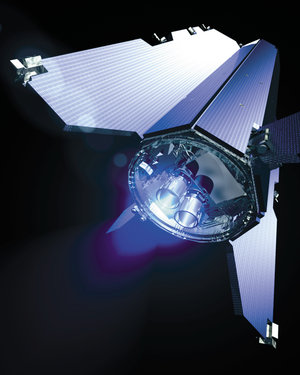GOCE’s ‘heart’ starts beating
GOCE’s highly sensitive gradiometer instrument has been switched on and is producing data. Forming the heart of GOCE, the gradiometer is specifically designed to measure Earth’s gravity field with unprecedented accuracy.
"We are very pleased with what we have seen from the gradiometer from the moment it was switched on. All accelerometer sensor heads are working in very good health and provide meaningful data," GOCE Project Manager Danilo Muzi said.
The gradiometer consists of three pairs of identical ultra-sensitive accelerometers, each mounted to point in orthogonal directions to allow the simultaneous measurement of the spatial variations of the gravity field.
With the switching on of the gradiometer, all systems on the satellite have now been activated. The satellite’s sophisticated electric ion propulsion system was switched on last week and continues to operate normally.

In order to get the maximum performance from the gradiometer, GOCE was designed to provide a highly stable and undisturbed environment. However, GOCE has to orbit Earth close enough to measure the tiny differences in gravity, which forces it to endure significant drag from the uppermost layers of the atmosphere.
The atmospheric drag is compensated for by the ion engine, which is able to deliver between 1 and 20 milliNewtons of thrust (the force equivalent to our exhaling).
GOCE was injected into orbit at an altitude of 283 km on 17 March. Since then, it has been freefalling at a rate of 150 to 200 m a day and will continue to do so until it enters ‘drag-free mode’ at an altitude of 273 km.
At this altitude, the satellite will actively compensate for the effect of air drag and its payload will undergo a further six weeks of commissioning and calibration. Mission operations are scheduled to start in summer 2009.
"With the ion engine and the gradiometer working, we have started to tune the satellite and its instruments," GOCE System Manager Michael Fehringer said.
"We have a lot of work ahead of us, but it is a highly exciting time for everyone involved in the mission," GOCE Mission Manager Rune Floberghagen added.
Data from GOCE will be used to create an extremely accurate map of Earth's gravity field. Together with altimetry data from missions, such as ESA’s Envisat, the GOCE gravity map will allow scientists to measure sea-surface height more accurately and understand sea-level change and ocean circulation better.















 Germany
Germany
 Austria
Austria
 Belgium
Belgium
 Denmark
Denmark
 Spain
Spain
 Estonia
Estonia
 Finland
Finland
 France
France
 Greece
Greece
 Hungary
Hungary
 Ireland
Ireland
 Italy
Italy
 Luxembourg
Luxembourg
 Norway
Norway
 The Netherlands
The Netherlands
 Poland
Poland
 Portugal
Portugal
 Czechia
Czechia
 Romania
Romania
 United Kingdom
United Kingdom
 Slovenia
Slovenia
 Sweden
Sweden
 Switzerland
Switzerland






























